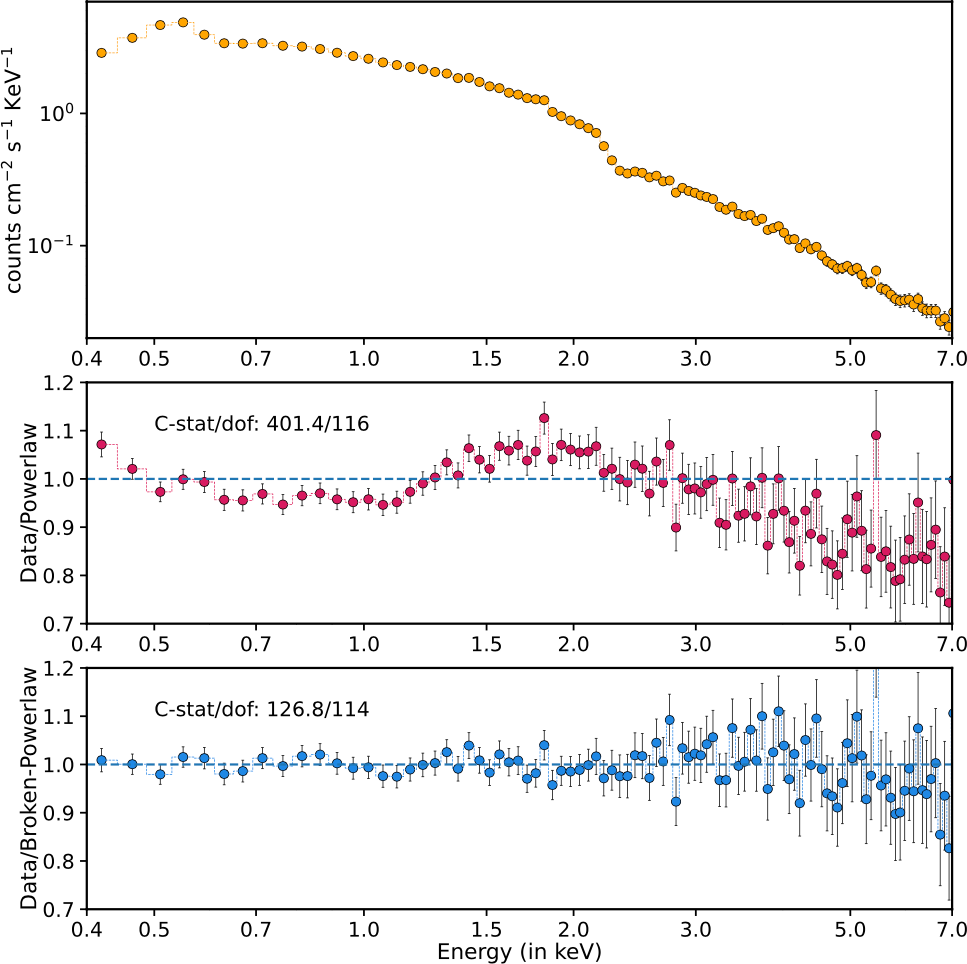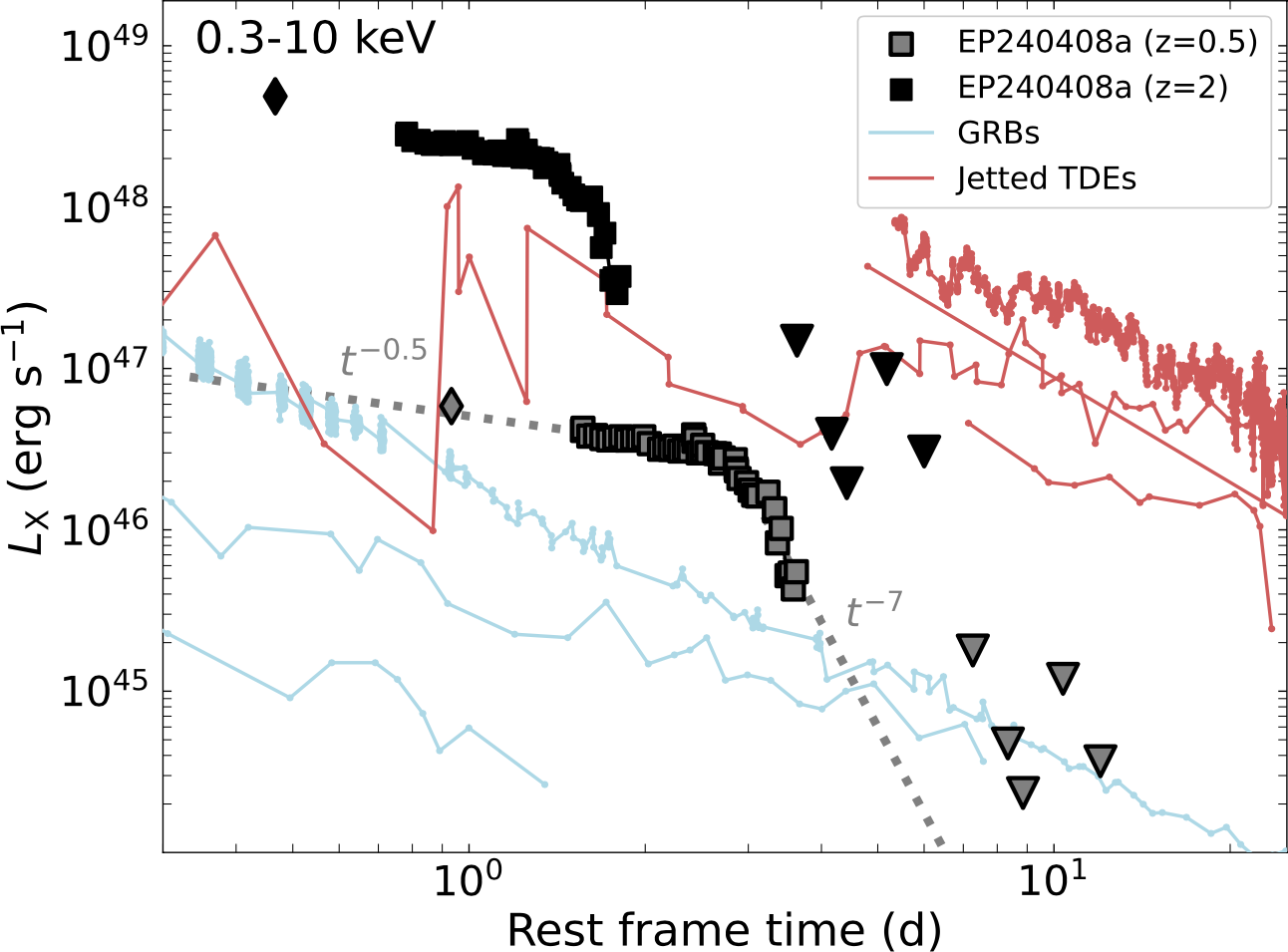NICER / ISS Science Nugget
for January 30, 2025
An exceptionally luminous X-ray transient
Some of the most energetic, and usually the most short-lived, events in the dynamic X-ray sky are cataclysmic explosions involving the destruction of stars. The collapse of a very massive star at the end of its life, forming a black hole, is thought to produce one type of gamma-ray burst ("long GRBs"), while the merger of two neutron stars produces another ("short GRBs"); the shredding of a star that passes too close to a massive black hole is the origin of the tidal disruption event (TDE) phenomenon. All are fleeting, but if they can be observed quickly enough, we can distinguish them by how their brightness evolves (usually meaning how quickly they fade), by their spectra (the dominance of low- vs. high-energy photons in their emissions), and by other measures such as their total energy output, Such discrimination is possible because these properties are shared among observed transients in each category, but are different between TDEs and the GRBs.
In April 2024, the Einstein Probe (EP) observatory detected a transient, dubbed EP240408a, in low-energy X-rays; the initial flash lasted less than 20 seconds. NASA's Swift telescope observed the transient's location approximately 1.5 days later, and NICER observations began a few hours after that (1.8 days after the EP trigger). The single Swift measurement revealed EP240408a to be already nearly 1000x dimmer than the initial bright flash detected by EP. NICER observed the target multiple times per day for the first week (including both orbit-night and -day exposures), and sporadically thereafter.
Ultimately, data from a half-dozen other facilities, spanning the radio to gamma-ray extent of the electromagnetic spectrum, were used to attempt to pin down the physical origin of this event; no gamma-ray, ultraviolet, optical, or radio transient could be identified that was clearly associated with EP240408a. The effort is described in a peer-reviewed paper, by B. O'Connor (Carnegie Mellon Univ.) and collaborators, published this week in The Astrophysical Journal Letters. NICER's intensive sampling of the early behavior enabled definitive analyses of the received spectrum and the trends in intrinsic energy output (luminosity) of the source. The spectrum exhibited a break - a change in the slope of measured brightness as a function of X-ray energy - around photon energies of 4 keV; such breaks often indicate that we are observing "down the barrel" of a jet of high-energy particles, a feature common to GRBs and, in rare cases of fortuitous geometry, TDEs. The luminosity evolution of EP240408a also included a break: a plateau lasting 4.2 days was followed by a steep drop that rendered the source undetectable within a single day. When these properties are compared with those of known GRBs and "jetted" TDEs, O'Connor et al. find that EP240408a is substantially brighter and matches neither of them well. Almost certainly, EP240408a originated in a distant galaxy, but the leading candidate host is so faint that it implies an enormous intrinsic luminosity for EP240408a, with an initial explosion that emitted more than 10^44 Watts of power. Only an extreme jetted TDE, or some unknown and entirely new type of explosive event, can explain EP240408a. Continued monitoring of the sky for new transients, revealing additional examples of such phenomena, will help pinpoint the origins of the most luminous transients in the universe.


Left: Cumulative NICER spectrum of EP240408a (upper panel) was fit to two types of models: one using a single "power-law" (a logarithmic decay in brightness with increasing energy; middle panel), and the other using a pair of power-laws with different slopes separated by a "break" at a given energy (bottom panel). A goodness-of-fit statistic (C-stat/dof), and the flatness of the data/model ratio (red and blue points with error bars), indicate that the broken power-law provides a better fit to the data. (Credit: O'Connor et al. 2025)
Right: NICER's luminosity measurements of EP240408a (grey and black squares) as a function of time are plotted twice, for two different values of the source distance as characterized by redshift 'z'. Because of time-dilation at different redshifts, the intrinsic ("rest frame") timescale of the source evolution is different. Measurements of past GRBs and jetted TDEs are shown in blue and red for comparison. (Credit: O'Connor et al. 2025)
<< Previous
Main Index
Next >>